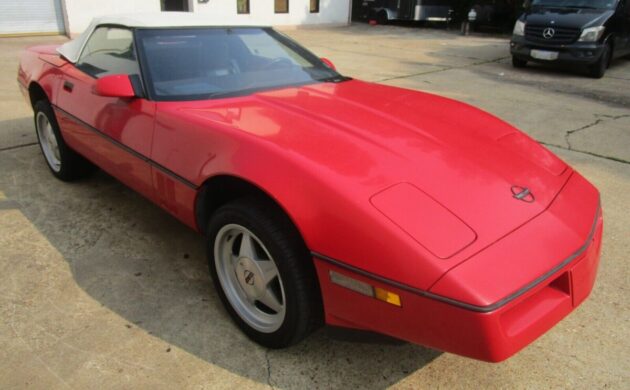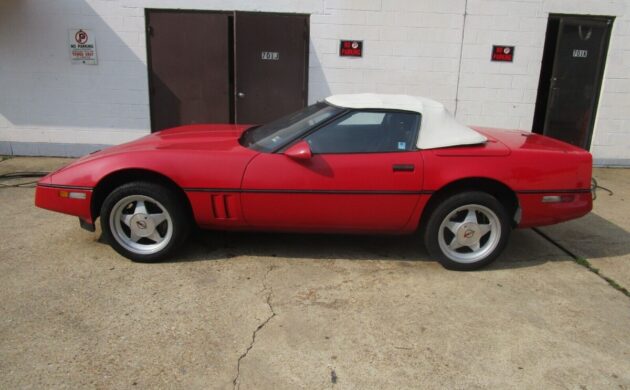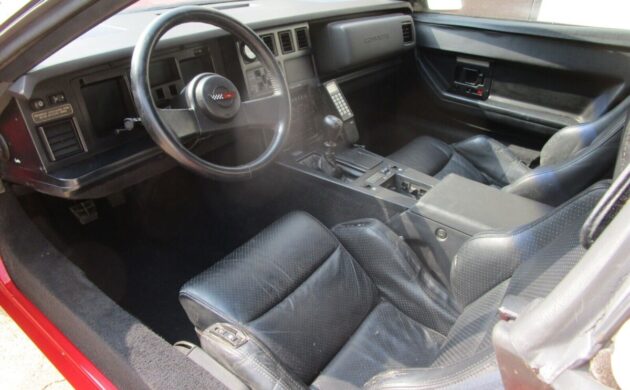Forced induction was one of the great motoring trends of the 1980s. Manufacturers and aftermarket tuning specialists realized that it offered endless scope for development that boosted performance significantly. Callaway Cars took the bull by the horns, releasing cars like this 1988 Corvette Twin Turbo. It is a rock-solid classic, but it has fallen on hard times. It needs a new owner willing and able to bring it back from the edge of extinction. The Corvette is listed here on eBay in Virginia Beach, Virginia. Frantic bidding has pushed the price to $ 6,350, which is below the reserve. The seller provides a BIN option of $10,500 for those who view this classic as a “must-have” item.
The original owner ordered this Callaway in Bright Red with a White soft-top. It is #9 of 124 examples produced in that model year and has been laid up since 1996. The paint has aged slightly, but the lack of significant flaws means it remains acceptable for a driver-grade vehicle. The seller supplies an underside shot confirming this classic is rock-solid. The soft-top continues the theme of acceptable presentation with no rips or tears. The back window is beginning to yellow, but that is a common fault that is easily addressed. The greatest cosmetic challenge for the new owner could rest with the unique Callaway wheels. They are straight and true, but the finish is peeling away. They require total restoration, a task best tackled by a specialist. The windshield is cracked, but the remaining glass looks okay.
Callaway was determined to extract the maximum available performance from its 1988 Corvette models, tackling the engine upgrades with a “total package” approach. The process began by stripping the engine to a bare block that was converted to four-bolt mains. A forged crank was bolted into place, with either Mahle or Cosworth pistons fitted to the end of stronger conrods. The cylinder heads received stainless steel valves and upgraded springs to improve reliability. With that work complete, a pair of water-cooled Rotomaster T04 turbos were attached, with twin intercoolers, special ducting to feed cold air, and a heavy-duty radiator completing the package. The result was a power and torque increase from 245hp and 340 ft/lbs to 382hp and 562 ft/lbs. This revealed itself in pure acceleration, with the Callaway slashing the Corvette’s ¼-mile ET from 14.4 seconds to 12.5 seconds. Top speed soared to 191mph, meaning the Callaway could show a clean pair of heels to most European exotics. The downside was the cost, with the Callaway package adding an eye-watering $26,995 to the Corvette’s sticker price. Lifting this classic’s hood reveals a lot of fresh air and why this once potent beast has lain idle for over two decades. The engine was stolen from a machine shop and was never recovered. It isn’t all bad news because many of the ancillaries remained with the car when the engine was shipped, and these are included. That makes a faithful rebuild possible, although it is likely to consume a considerable amount of cash.
There was little to distinguish a Callaway interior from a regular Corvette beyond the numbered dash plaque. The only aftermarket addition is a car phone, and the only notable faults are the cracked dash pad and some minor wear on the outer leather seat edges. The former requires a pad replacement, while the latter might respond to the attention of a leather specialist. Otherwise, a deep clean should recapture much of its former glory. The winning bidder receives a classic equipped with air conditioning, power windows, power locks, power seats, a leather-wrapped tilt wheel, and an AM/FM radio/cassette player.
Determining whether a classic strikes the right chord with enthusiasts can sometimes be challenging, but this 1988 Callaway Corvette Twin-Turbo leaves no doubt. It has received an impressive 106 bids, with time remaining for that total to rise significantly. If the car were left in its current cosmetic state but had a correct engine slotted back under the hood, it could command a price above $30,000. Returning it to a factory fresh state could boost that figure beyond $45,000. Are you tempted to take a punt and join the bidding war on this gem?








That’s one war I’d sit out. The most valuable part of the car isn’t there. Leaves room for an LS swap.
I agree, equal the horsepower or more with a LS motor. Sell off the Callaway stuff and make a nice driver.
What a joke, and not a very funny one. “Twin Turbo Project: It Just Needs The Twin Turbo” might have been a better caption.
I thought Callaways had twin NACA ducts near the leading edge of the hood?
Thought so too. Maybe the first didn’t. Someone here will pipe up.
A good friend of mine who owns a restoration shop in Massachusetts and restores sports and race cars along with hot rods met with Reeves to discuss the NACA ducts in the hood in the 80’s.
Since the passing of Reeves these cars will skyrocket in price.
I’m curious why they will “skyrocket” in price. Callaway is still in business.
A low production run back then in the 80’s because of the a small shop and just starting out. It’s not just a Corvette, its a Calloway Corvette. Twin Turbos were rare back then for a Corvette. People are willing to pay more just because of the marque. A Corvette collection is not complete if it doesn’t have a Calloway. Lets see how many hit the Block at Mecum or Barrett in the next year or two.
I’m in agreement on the Naca ducts, along with the special Callaway front bumper cover not being present. I’m no Callaway expert but to me it doesn’t look like a Callaway without the right body panels. I don’t know if some didn’t have the body panels we know to indicate it’s a Callaway.
Two things about the C4 versus the C5 that are in the C5’s favor are the much improved chassis structure stiffness because the C5 had a backbone frame and the suspension design. The C4 rear suspension used lateral links below the axles with big squishy rubber donuts (exaggerating a bit) that with good tires, would compress under cornering load, causing severe enough positive camber on the outside rear tire, that the rear end would break away so fast it was hard to catch. The ’88 and later C4s were much improved, with a different lower bracket attached to the bottom of the differential that located the inner pivots closer to the ground, reducing the camber change and roll center height. You can retrofit the bracket to the earlier cars, but you have to drill out the holes in the aluminum differential housing, which I did, and autocrossed the car (also a red convertible) hard, plus 40,000 miles of street driving with no trouble. That, plus replacing the rubber bushings with either aftermarket tubes with rod ends, or fitting spherical bearings instead of the rubber bushings, makes the rear suspension better than the C5, because it will put power to the ground exiting a corner sooner due to more advantageous anti-squat geometry. Also, as bulky as they look, these things (at least without the add-on weight from the turbo system) were a little over 3200 lbs.
As expected it’s gone for cheap money.
With the exhaust pipes, mufflers and “X” brace also missing. I guess what makes this an $8500 Callaway are the wheels and the dash plaque.